|
Monmouth Troy & the Wye Valley line remembered
Terry Harper remembers Monmouth Troy
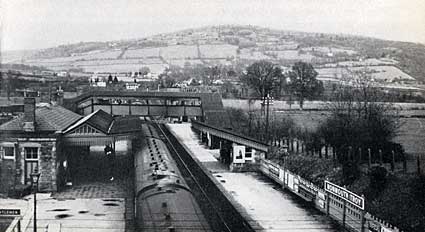
Monmouth Troy station, 1931.
I was at school at Monmouth until 1951, and the lines from Chepstow,
Ross-on-Wye and Pontypool Road were all open. That to Coleford had closed in
1916.
Each line had a GWR autotrain or diesel railcar operating, with about 4 or 5
round trips per day, and there was a daily goods service on each line, as
far as I can remember. Possibly more on cattle market days.
The bustle of activity around Troy happened just before 9 am and just before
4 pm, when all the school trains were getting into position.
The train from Ross called at Mayhill to disgorge and pick up its load, while that from
Pontypool Road continued from Troy to May Hill for the same purpose, having
presumably collected the boys and girls from the Severn Tunnel Junction
train before it did so.
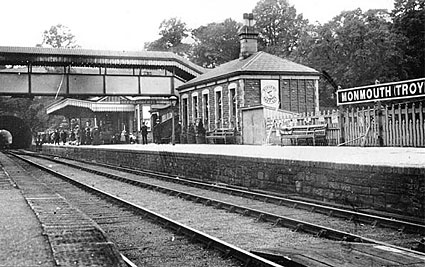
The afternoon manoeuvres were often observed from the school playing fields. Different combinations of 0-4-2Ts, 0-6-0PTs and
the odd diesel railcar were involved, with autocoaches on the steam trains.
Add to that at least one goods train being shunted and it took on an air of
business all of its own.
The biggest train I ever saw was headed by two of the light GWR 2-6-2T tanks
with the small driving wheels, and had about 14 carriages. I think it was a
troop movement special, heading non-stop through from Pontypool Road towards
Ross-on-Wye.
Probably about 1945, but could have been later. We were
watching a cricket match, so it would have been a Saturday afternoon.
Terry Harper, August 2004.

Working the line.
We're grateful to Fred Beach for sending in this photo of his father working on the line between Wysham and Redbrook in the late 50's.
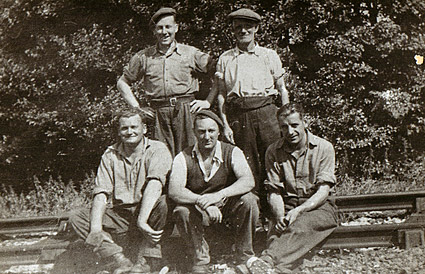
Left to right: back row: Fred Beach, Ted Blunt (ganger). Front row: Ivor Jacques, Fred Bevan, Alfie Pearce
 My dad joined the GWR in 1936 as a painter at Paddington Station, he was in London working as a barman with a mate, and probably having a good time.
He moved back to Monmouth but could only get a job as part of the Lydbrook gang which operated between Lydbrook annd Mayhill Station, Monmouth. I remember waving to him near Lydbrook junction as we passed on the Ross train in the early 50's. I have the letter confirming his move to the St Briavels gang which seems to have operated between Tintern and Troy, we lived at Wyesham so he could hop on and off trains as they passed. Gangs did join forces and overlap when more manpower was needed, I remember he once worked on weekends in the Severn Tunnel. My dad joined the GWR in 1936 as a painter at Paddington Station, he was in London working as a barman with a mate, and probably having a good time.
He moved back to Monmouth but could only get a job as part of the Lydbrook gang which operated between Lydbrook annd Mayhill Station, Monmouth. I remember waving to him near Lydbrook junction as we passed on the Ross train in the early 50's. I have the letter confirming his move to the St Briavels gang which seems to have operated between Tintern and Troy, we lived at Wyesham so he could hop on and off trains as they passed. Gangs did join forces and overlap when more manpower was needed, I remember he once worked on weekends in the Severn Tunnel.
Fred Beach August 2009.

Monmouth Troy - forgotten railway
James Page, 1980
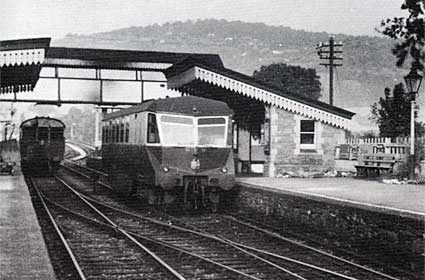
Railcar No 23 arrives at Monmouth Troy station with the 6.01pm from Chepstow, 12th September, 1949.
Monmouth (Troy) was the focus of all the branches from the east, west and south. Yet in the tradition of a country station it was
not even in Monmouth, but stood beneath a hill nearly a mile to the south-west of the town.
Facilities included a single-storey ticket office, waiting room, porters' room etc, with a full-length awning; a small shelter with a similar awning stood on the opposite platform.
A covered footbridge linked the two. Immediately west, on the branch to Usk, was a short tunnel (148yds) of twin bore.
Only the northernmost line was a running line, the other was a siding. Goods facilities were adequately provided for in a yard containing six sidings, on one of which stood the large goods shed, and on another, cattle pens.
The separation of the branches to Ross and Chepstow occurred as a double junction at the east end of the platforms.
Movements were controlled by the adjacent signalbox, which like all major buildings was built of the attractive local sandstone.

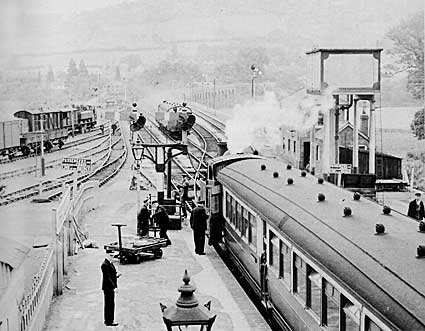
A bustling scene at Monmouth Troy in 1950 [photo: Ian Allan Library]
From at least the turn of the century until World War II the services on the branches from Pontypool Road to Monmouth and Monmouth to Ross-on-Wye were run as a through service. Initially four through trains daily were run, but later this was cut to three.
These were in addition to shorter workings, viz.
Pontypool Road to Usk or Monmouth, or Ross-on-Wye to Lydbrook junction. The Chepstow branch services were always separate, and for many years consisted of five trains each way daily, and until 1916 augmented by a connecting service off the Coleford branch.
Connections between all these services were made three times a day, giving Troy its busiest periods.
The first connection was about 9.00am, followed by two others at around midday and 4.00pm, the precise times varying slightly over the years.
For many years the goods yard was kept busy by three workings daily, one each from each of the branches. The first, from Chepstow, arrived at 1O.45am and departed at I2.20pm.

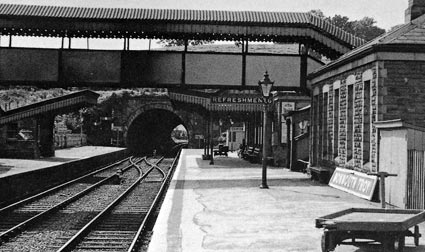
There was still a refreshment room available in this Sept 1954 view [photo: N Simmons]
The Pontypool Road freight arrived 25 minutes after the Chepstow train and hung around until 5.00pm. Finally the Ross-on-Wye working rattled in at 1.40pm, departing an hour and five minutes later.
At midday Troy station really bustled with three passenger and two freight trains busying themselves within its precincts.
Motive power over the years was provided by six-coupled saddle and pannier tanks, 517 and, 14xx (or should 1 say 48xx) 0-4-2Ts, and in the 1950s the occasional GWR-designed diesel railcar.
With the exception Of 45XX 2-6-2Ts nothing larger was allowed on any of the branches. In turn, these classes busied themselves in this delightful backwater for over a century.
Now, where the shrill whistle of the steam locomotive was once heard, the air throbs with the sound of the diesel-engined road juggernaut.
Excerpt from 'Forgotten Railways of South Wales'
David & Charles, ISBN: 0715377345. November 29, 1979.

|
|






